

CONTENTS

In the spring of 1943, Pete Tolles of the J. Walter Thompson Company invited Harold Horman and Edward Rondthaler of Photo-Lettering and Gus Holt and Ross Morris from BBD&O for an informal lunch. This lunch group grew over the following months and soon Frank Powers, Petes assistant at JWT, joined the group. In those days type specifiers in agencies were either art directors or production men. Frank Powers and Jim Secrest coined the term type director to give the role a more professional standing. In three years the informal luncheon group became the Type Directors Club, and Frank Powers became its first president.
The Type Directors Club hosted what became an annual series of ten lectures in 1947. The next years series was moved to a larger venue at the Willkie Memorial Building at 20 West 40th Street, across the street from Bryant Park. In 1949, the Ten Talks included presentations on the development of the printed word, type textures, type recognition, individualism in typography, mechanics of advertising type, type and direct advertising, wood engraving, publication typography, and advertising typography. The TDC continued its lecture series through the 1950s and added a show of Club members works in 1952. The topic in 1955, See for Yourself, was a coming-out party for the first TDC competition, and the final nights presentation was a roundtable discussion by the judges. The second annual TDC show was held in 1956, and this one had a catalog of the winning entries.
This was the Clubs first Annual in the continuous line that resulted in this years Typography 33. The Silvermine Artists Guild in New Canaan, Connecticut, was the site in 1958 of the first-ever conference on typography. The World Seminar attracted more than 500 people who attended the daylong affair with speakers including Ottl Aicher from Germany, Max Huber from Italy, Yusaku Kamekura from Japan, W.J.H.B. Sandberg from the Netherlands, Herbert Spencer from England, and chairman Will Burtin from the U.S. The 200-piece TDC show was hung throughout the space, giving it quite a celebratory feeling. In 1959, the TDC sponsored Typography USA at the Biltmore Hotel.
The panel discussions featured Saul Bass, Herbert Bayer, Lester Beall, Will Burtin, Lou Dorfsman, Alvin Eisenman, Gene Federico, William Golden, Allen Hurlburt, Leo Lionni, Herb Lubalin, Paul Rand, Ladislav Sutnar, and Bradbury Thompson. After its founding in the wake of the Second World War, the TDC soon became an international organization. In the late 1950s and early 1960s, type designers and typographers in Europe joined the Club or were named honorary members. The show of winning entries in the Clubs competition was sent to cities across the United States, and then to Canada, Europe, and Japan. Today, seven shows of the previous years winners are sent simultaneously around the world. The Clubs first international liaison was Olaf Leu in Frankfurt, who arranged for the shows visit in 1968.
The Club now has liaisons representing Germany, the U.K., France, Spain, Japan, Mexico, Vietnam, and South America. With many more typefaces being submitted to its competition by designers around the world, the Club has named a standing non-Latin Advisory Board that provides guidance and advice to the judges of the TDC typeface design competition. The first TDC newsletter, Gutenberg & Sons, was published in 1983. It evolved into Letterspace, which has given way to entries on the Clubs website. Still, the need for a printed presence remains, and the Club enjoys the efforts of noted typographers in a series of keepsakes and promotional pieces. The TDC gave its first medal for excellence and achievement in the typographic arts in 1967 to Hermann Zapf.
It awarded the twenty-fourth and twenty-fifth medals to Mike Parker and Erik Spiekermann in 2011. The Club has promoted and supported education since its inception. We host regular classes and seminars at the TDC office taught by visiting international designers and our own board members. The TDC has worked closely with the Cooper Union in developing the first postgraduate Certificate in Typeface Design in the U.S. The Club continues to award annual scholarships to design students around the world. This years recipients are from the School of Visual Arts, UCLA, Pratt Institute, the Cooper Union, and Whanganui School of Design in New Zealand.
Lectures remain an ongoing effort of the Club. Monthly Type Salons were started in 2002 as a way of encouraging a more club-like feeling, at least for its New Yorkarea members. The Salons started as casual presentations by members, then became publicized events that now keep the Clubs space on West 36th Street busy a few evenings a week. Salons began this year to be webcast live around the world. The Type Directors Club has become robust under the guidance of Executive Director Carol Wahler, who celebrates her twenty-ninth year in that leadership position. ALEX W. ALEX W.
WHITE, PAST PRESIDENT AND CHAIRMAN

Like so many designers and typographers, I discovered the Type Directors Club through this book. The work on these pages back then opened my eyes to a new world of possibilities with typography. Soon after seeing the book in the mid-1990s, I joined the TDC. I joined not for the perks and discounts or the mention on my rsum, but because the Club stood for somethingand by joining, I became a part of it. For sixty-five years, the Type Directors Club has represented something more than a book or a competition to its members. It is a constant.
Its an old friend. A mentor. Its a beacon. Its a community of like-minded designers carrying on the mission to promote excellence in typography. For those who value type, the TDC represents an indispensable resource, fostering and nurturing various forms of typographic exploration and preservation in any medium. Today, being part of a real global community sharing a common mission is more important than ever.
With so many outlets offering an artificial sense of community, its comforting to know that TDC provides its members with a true sense of belonging and purpose. Getting something out of a TDC membership means putting something in. The work I put in on the TDC board and as the web committee chairman over the past four years has paid immeasurable dividends, both professionally and personally. Ive had the opportunity to meet and work with some of the most talented typographers in the world and form lasting friendships. But perhaps the biggest reward came when I was selected as the chairman of TDC58. Having the privilege of being the competition chair person afforded me the honor of working with Paula Scher.
Paula dedicated her valuable time and talent to develop a beautiful and extensible design system that spoke universally to our global audiencereinforcing the sense of welcoming and community that the TDC embodies. Thank you, Paula. The weight of the responsibility that comes with carrying on this 58-year-old tradition by selecting a jury to judge the best typographic work in the world was not lost on me. For this task, I had one goal: capture the same diversity of talent that exists in the Clubs membership base and in the world of typography today. Id like to thank each of the jurors who did just that. By sharing their energy and expertise they have selected work that will stand as a record of the typography of our time, and we hope this will move a new generation of artists to discover type and to get involved with something greater.
Next page
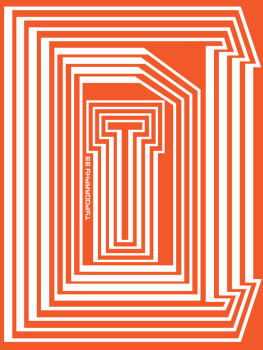
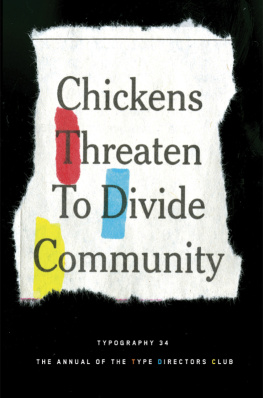
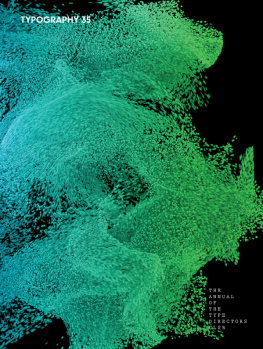


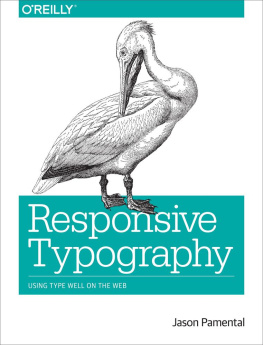
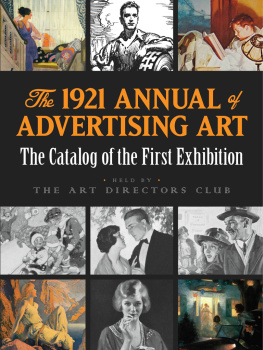
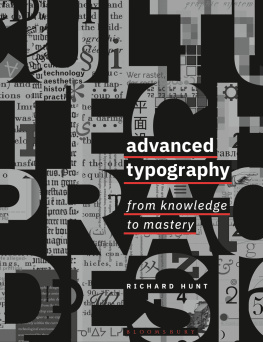
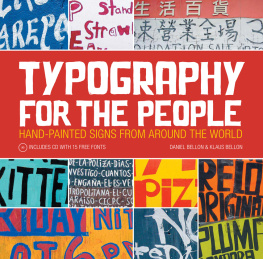
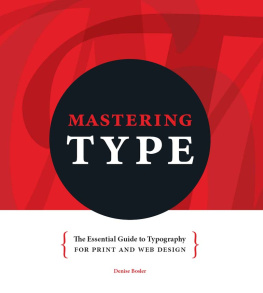
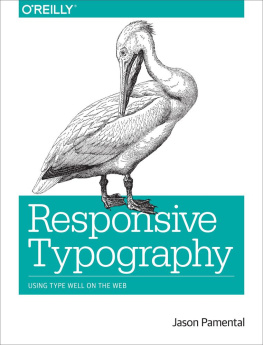
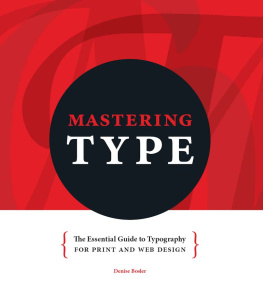


 In the spring of 1943, Pete Tolles of the J. Walter Thompson Company invited Harold Horman and Edward Rondthaler of Photo-Lettering and Gus Holt and Ross Morris from BBD&O for an informal lunch. This lunch group grew over the following months and soon Frank Powers, Petes assistant at JWT, joined the group. In those days type specifiers in agencies were either art directors or production men. Frank Powers and Jim Secrest coined the term type director to give the role a more professional standing. In three years the informal luncheon group became the Type Directors Club, and Frank Powers became its first president.
In the spring of 1943, Pete Tolles of the J. Walter Thompson Company invited Harold Horman and Edward Rondthaler of Photo-Lettering and Gus Holt and Ross Morris from BBD&O for an informal lunch. This lunch group grew over the following months and soon Frank Powers, Petes assistant at JWT, joined the group. In those days type specifiers in agencies were either art directors or production men. Frank Powers and Jim Secrest coined the term type director to give the role a more professional standing. In three years the informal luncheon group became the Type Directors Club, and Frank Powers became its first president.  Like so many designers and typographers, I discovered the Type Directors Club through this book. The work on these pages back then opened my eyes to a new world of possibilities with typography. Soon after seeing the book in the mid-1990s, I joined the TDC. I joined not for the perks and discounts or the mention on my rsum, but because the Club stood for somethingand by joining, I became a part of it. For sixty-five years, the Type Directors Club has represented something more than a book or a competition to its members. It is a constant.
Like so many designers and typographers, I discovered the Type Directors Club through this book. The work on these pages back then opened my eyes to a new world of possibilities with typography. Soon after seeing the book in the mid-1990s, I joined the TDC. I joined not for the perks and discounts or the mention on my rsum, but because the Club stood for somethingand by joining, I became a part of it. For sixty-five years, the Type Directors Club has represented something more than a book or a competition to its members. It is a constant.